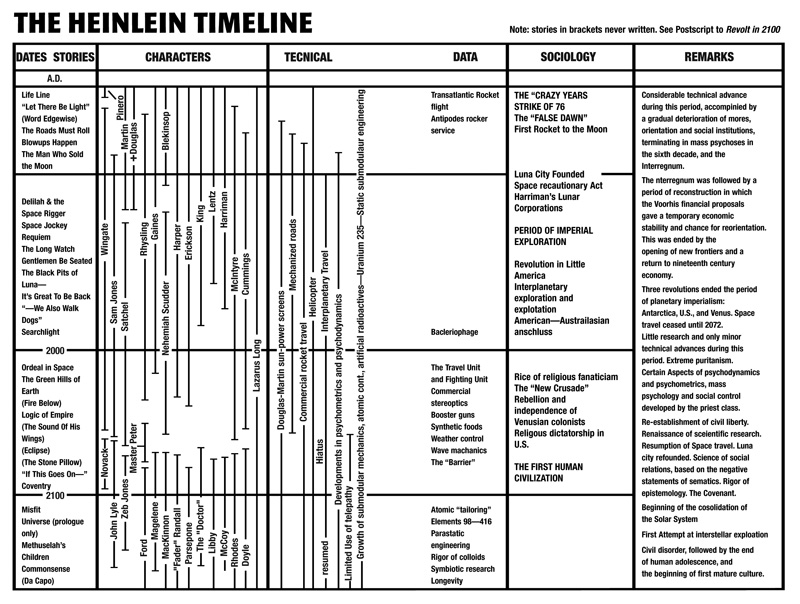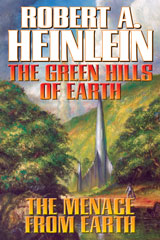

The large-scale tapestry effect of a historical trend-line extrapolated into the future startled and delighted John W. Campbell, Jr., when Heinlein mentioned it in passing in 1940—and then startled, delighted, and even awed science fiction readers when Campbell published an expanded version of the Future History chart in May 1941. No one knew the concept of a Future! History! had been missing from science fiction until, suddenly, there it was.
Heinlein's Future History came together by accident, indirectly, and built on the work of predecessors. He mentioned Galsworthy's Forsyte Saga—and did not mention but was clearly influenced by James Branch Cabell's part-fantasy, part-realistic social satires of the Biography of the Life of Manuel.
The germ of Heinlein's own tapestry of the future, though, was the backstory he had created for his first novel, For Us, the Living, in 1938. Set in the twenty-first century, it gave its-history-our-future, and Heinlein used the backbone of that history-of-the-future to generate an entirely new line of stories. In the spring of 1939, Heinlein began assembling ideas for a try at writing for pulp and included incidents from that fictional history (along with some new-age ideas and even some shaggy dog stories). "Life-Line," the first story he sold, was not taken from that history-of-the-future, but his second story, "Misfit," was. The next six stories he wrote were not—and failed to sell.
A pattern was beginning to emerge.
By August 1939 Heinlein began to work up a novella he had started in the spring. "Vine and Fig Tree" was very much in the For us, the Living history-to-come—how the United States recovers from a religious dictatorship. He wanted to interconnect the various stories as he wrote them, mentioning names and incidents from one story in others. But there was so much accumulated detail that he found himself having to sift through his entire pile of notes whenever he wanted to drop such a reference. He thought of the method Sinclair Lewis said he used to organize his own interconnected stories and novels of the fictional city of Zenith in the equally fictional midwestern state of Winnemac: a wall chart.
"So I took an old navigation chart, about 3 x 4 feet," Heinlein related for his colleagues in the Science Fiction Writers of America bulletin in 1975, "turned it over, made the time scale vertical, then set up five columns: stories, characters, technical data, sociological, remarks."
He transferred his notes to the chart, and when he was done he could see at a glance (always providing he could read his handwriting) just how everything related to everything else at the time of his story. The chart stayed on the wall by Heinlein's typewriter, "and was usually messy as I never took the chart down to add to it—just reached over and scrawled on it."
Casually, on his first trip to New York as a new-minted pulp writer, Heinlein mentioned the chart to Campbell, who thereafter nagged him to publish it—which he did in the May 1941 issue of Astounding (along with "Universe" and "Blowups Happen" in the same issue).
After World War II, Heinlein worked his stories for the prestige popular magazines into the Future History, and they defined the "middle years" of the progression, published by Shasta Press as the second volume of the Future History, The Green Hills of Earth and Other Stories. But Destination Moon and the Post stories made Heinlein a public figure, and his genre audience became an ever-shrinking proportion of his readership, finally vanishing altogether in the statistics of his last books, issued in million-copy pressings.
But the Future history would not go away, and one story in particular remained on Heinlein's "do—soon" agenda for twenty years. He might have written "Da Capo" for the Shasta Future History series in the early 1950s, but the restrictive contract Shasta wanted for "The Man Who Sold the Moon" turned out so expensive to Heinlein that he gave up the idea of writing any more of the novellas that would have filled the gaps in the Future History (the volume that became The Green Hills of Earth and Other Stories, for example, was originally conceived as The Sound of His Wings—the story of Nehemiah Scudder's theocracy that would have preceded "If This Goes On—" The same volume was to have another freshly-written novella, "Fire Down Below," the story of a colonial revolution in Antarctica.
"Da Capo" would have been a very different story if written in the 1950s than it became in 1973 as the concluding section of Heinlein's most complex and ambitious book to date, Time Enough for Love.
But Heinlein was to become more ambitious yet in the 1980s. The Number of the Beast (1980) finds Lazarus Long and his Boondock/Tellus Tertius family grown in scope to take in a war in the Cosmic All, across all the universes of all the fictions that could be—and all the realities that could be. The Future History was now one thread in the Multiverse, code-named Timeline: Leslie LeCroix (after the first man to set foot on the Moon. Our consensus reality was code-named Timeline: Neil Armstrong).
Although a few readers were disappointed by Heinlein's drawing together of all his writing into a single, coherent schema, he was simply acting out a basic literary drive: after all, what is T.S. Eliot's "order of literature"—one of the seminal critical insights of the twentieth century—if not an attempt to draw all literature of all times and languages into a single, coherent schema?
Heinlein's World as Myth allows us to see the relatedness to the Future History of all the stories of The Menace From Earth, not merely the title story (one of Heinlein's most engaging vignettes of life in an exciting time for the human race). "Columbus Was a Dope," we understand, and "Sky Lift" are happening somewhere else in the Multiverse, somewhere quite close by the Future History. Other stories—"Water Is for Washing" and "Year of the Jackpot"—take place in universes further away—and possibly up a different space-time axis.
But never mind! The Circle of Ouroboros patrols all these universes and many more. And the Time Corps retrieves from all those times little treasures of storyteller's art, returning always to the home base Heinlein authored for himself: TIMELINE: LESLIE LECROIX.
